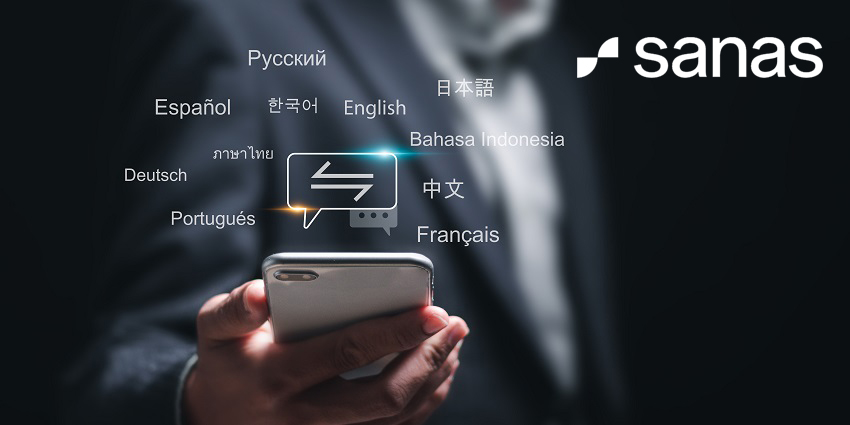When we think of AI in the contact center, our minds often go to chatbots, predictive analytics, and automated workflows.
But Sanas is introducing a different kind of innovation – one that operates not in what is said, but in how it sounds.
Sanas is a speech understanding technology company that enables real-time accent translation, noise cancellation, and speech enhancement – and recently announced a live language translation solution.
Their flagship accent translation capability works at the flick of a digital switch. An agent’s natural speech is rendered in a different accent, while preserving their words, tone, and identity.
It’s not dubbing, and it’s not voice replacement; it’s an adaptive layer that enhances voice communication, aiming to improve understanding, clarity, and confidence in conversations where accents, background noise, and low-fidelity audio might otherwise be a barrier.
Shawn Zhang, Co-Founder and CTO at Sanas, expanded on this, stating:
“In real time, we modulate the accent and pronunciation from one accent distribution to another depending on the listener.”
What Makes It Different?
What sets Sanas apart isn’t just the underlying technology; it’s the intent behind it.
Most speech-to-text or voice synthesis tools are focused on automation or replication. Sanas, by contrast, sits in the service of human-to-human conversation.
It’s about making people feel heard, not just literally, but experientially.
“Where many solutions try to remove the human from the loop, Sanas keeps the agent front and center, simply adapting how their voice is heard to meet the listener’s expectations or preferences,” added Zhang.
That capability can have striking operational impacts for CX teams: reduced handle time, improved comprehension, and increased agent confidence.
The technology can also be used to help humanize the customer experience and service industry, as Zhang explains:
“Everyone has a unique part of their voice. Accent is a very core piece of everybody’s identity. And it is because of that fact that we find it incredibly disheartening to feel that an accent might prohibit an agent from getting a job and performing in that job.”
For Sanas, This is Personal
The inspiration behind Sanas wasn’t born in a boardroom; it started with a phone call from a friend.
While students at Stanford, the Sanas founders stayed in touch with a former classmate who had returned home to Nicaragua and taken a job in a local contact center.
On paper, he should have excelled. But when they asked how things were going, his answer cut deeper than expected.
“He told us he hated the job,” recalled co-founder Shawn Zhang.
“Not because he wasn’t good at it – he was solving technical problems, resolving customer issues, doing everything right – but callers would constantly complain about the way he sounded.
“It was his accent, not his ability, that they couldn’t get past.”
That moment revealed a painful disconnect: someone with the skills and commitment to help was being undermined by nothing more than how he spoke.
From that frustration came a question: what if technology could help bridge the accent gap without asking the person to change how they naturally speak?
Rethinking the Ethics
The initial reaction many have when hearing about accent translation is one of concern: isn’t this erasure? Doesn’t it imply certain accents are more desirable than others?
These are important questions – and worth asking – but when you look closer, the story becomes more nuanced.
For many agents, especially in outsourced CX environments, accent bias isn’t theoretical; it’s lived.
Harassment, misunderstanding, and dropped calls happen not because of poor language skills, but because of bias or unfamiliarity.
Moreover, outsiders might not realize that without solutions like Sanas’, contact center agents often undergo ‘accent neutralization’ training.
Not only is this costly and time-consuming, but the process of coaching someone to speak differently than their natural intonation strips them of a core aspect of their identity.
“We want to make sure that this is something that improves both parties in the conversation, right?” says Zhang.
Rather than enforcing conformity, accent translation can be viewed through the lens of accessibility, enabling agents to speak naturally and customers to understand easily.
Zhang built on this:
“Obviously, for the listener, they’re able to understand more easily, just because these are pronunciations that they’re a little bit more familiar with hearing.
“For the contact center agent, they’re having a much smoother experience because they don’t have to repeat themselves.”
It is this dual benefit for both customer and agent that Zhang really emphasizes, making conversations better for everyone involved.
How Enterprises Can Implement Accent Translation
As more enterprises look to reduce communication friction and empower their agents, technologies such as accent translation are being implemented.
But where does an enterprise begin when deploying something this transformative? And what must they consider?
For most enterprises, adopting accent translation starts with a clear motivation: to improve clarity, comprehension, and customer satisfaction.
Sanas doesn’t change what agents say. It changes how they are heard.
Through real-time accent conversion layered over natural speech, the software allows agents to communicate in a way that resonates better with their audience, without replacing their voice or identity.
Key Considerations for Deployment
Cultural and Agent Sensitivity
Implementing accent translation isn’t about enforcing uniformity; it’s about offering choice.
Zhang explained that enterprises must prioritize transparency and agent agency when introducing the tool.
Unlike tools that sideline the human, Sanas prioritizes the agent first, shaping how their voice is received so it resonates with the customer.
The key message to contact centers? Bring agents on the journey.
For Zhang, focusing on employee satisfaction is an essential component of this.
“You have to ask your agents what they think about the accent translation service? Is this something that you guys are enjoying?
“Can you tell the difference between your day-to-day job and operations now?”
This dialogue ensures that the employee experience is given just as much credence as the customer experience.
Integration and Infrastructure
Sanas is designed to be easy to deploy, but pre-implementation operational questions may remain: does your current voice infrastructure support real-time routing? Will it sit alongside existing agent-assist tools? How does it integrate with quality monitoring?
Zhang acknowledged this:
“I know that integration is a big friction point [in the contact center space], and I know enterprises assume that there are a lot of steps that come with integrating a new product into their own platform.
“The beauty of Sanas is that we built our algorithm as a virtual microphone.”
Zhang emphasized that implementation doesn’t require complex change management: Sanas scales quickly across contact centers, runs securely on-device, and integrates with virtually any CRM or platform.
From there, “Sanas is in the middle to empower those conversations. It’s very easy for IT to implement.”
Measuring Impact
Like any CX initiative, what gets measured matters.
Beyond anecdotal feedback, enterprises should track contact center KPIs such as average handle time, CSAT, and agent engagement.
Understanding both the quantitative and qualitative impact is key to long-term success.
Zhang said:
“You want to look at these business KPIs: have customer satisfaction scores increased? What has been the response from our customer base? And how does this translate in terms of average handling times?”
Looking Ahead
As voice AI and speech understanding continue to mature, Sanas represents a subtle yet powerful shift: one that doesn’t automate the human out of the conversation, but instead enables understanding.
For enterprises ready to embrace that shift, the road forward begins not just with implementation but with intention.
By prioritizing agent agency, measuring meaningful outcomes, and recognizing accent translation as a tool for accessibility, organizations can create more inclusive, compelling customer experiences.







